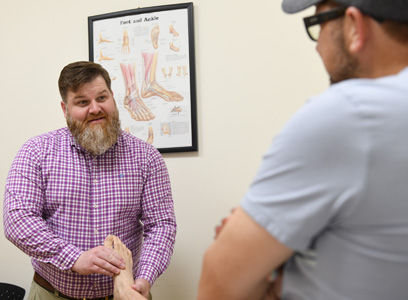Hallux Rigidus
 Hallux Rigidus (Stiff Big Toe)
Hallux Rigidus (Stiff Big Toe)
Hallux rigidus is a disorder of the joint located at the base of the big toe. It causes pain and stiffness in the joint, and over time, it gets increasingly more difficult to bend the toe. Hallux rigidus is actually a form of degenerative arthritis that can be very troubling and even disabling, since we use the big toe whenever we walk, stoop down, climb up, or even stand.
Because hallux rigidus is a progressive condition, the toe’s motion continues to decrease as time goes on. As the problem advances, the toe’s range of motion gradually decreases until it potentially reaches the end stage of “rigidus,” in which the big toe becomes stiff, or what is sometimes called a “frozen joint.”
Symptoms
If you find it difficult to bend your toe up and down, or find that you are walking on the outside of your foot because of pain in the toe, see your Celebration Orthopaedics podiatrist right away. Early signs and symptoms include:
- Pain and stiffness in the big toe during use (walking, standing, bending, etc.)
- Pain and stiffness aggravated by cold, damp weather
- Difficulty with certain activities (running, squatting)
- Swelling and inflammation around the joint
As the disorder gets more serious, additional symptoms may develop, including:
- Pain, even during rest
- Difficulty wearing shoes because bone spurs (overgrowths) develop
- Dull pain in the hip, knee, or lower back due to changes in the way you walk
- Limping (in severe cases)
Causes
Common causes of hallux rigidus are faulty function (biomechanics) and structural abnormalities of the foot that can lead to osteoarthritis in the big toe joint. This type of arthritis results from “wear and tear” and often develops in people who have defects that change the way their foot and big toe functions. For example, those with fallen arches or excessive pronation (rolling in) of the ankles are often susceptible to developing hallux rigidus.
In some people, hallux rigidus can run in the family and is a result of an inherited foot type that is prone to developing this condition. In other cases, it is associated with overuse and activities or jobs that increase the stress on the big toe, such as workers who often have to stoop or squat. It can also result from an injury, such as stubbing your toe, or it may be caused by inflammatory diseases such as rheumatoid arthritis or gout. Your Celebration Orthopaedics foot and ankle surgeon can determine the cause of your hallux rigidus and recommend the best treatment.
Treatment Options
In many cases, early treatment may prevent or postpone the need for surgery. Treatment for mild or moderate cases of hallux rigidus may include:
- Shoe modifications: Shoes with a large toe box put less pressure on your toe. Stiff or rocker-bottom soles may also be recommended.
- Orthotic devices: Custom orthotic devices may improve foot function.
- Medications: Oral nonsteroidal anti-inflammatory drugs (NSAIDs), such as ibuprofen, may be recommended to reduce pain and inflammation.
- Injection therapy: Injections of corticosteroids may reduce inflammation and pain.
- Physical therapy: Ultrasound therapy or other physical therapy modalities may be undertaken to provide temporary relief.
In some cases, surgery is the only way to eliminate or reduce pain. There are several types of surgery for the treatment of hallux rigidus. In selecting the procedure or combination of procedures for your particular case, the foot and ankle surgeon will take into consideration the extent of your deformity based on the x-ray findings, your age, your activity level, and other factors. The length of the recovery period will vary, depending on the procedure or procedures performed.
Possible surgical procedures can include:
- Cheilectomy. This surgery is usually recommended when the damage is mild or moderate and involves removing the bone spurs as well as a portion of the foot bone, so the toe has more room to bend. The toe and the operative site may remain swollen for several months after the operation, and you will have to wear a wooden-soled sandal for at least two weeks after the surgery. But most patients do experience long-term relief.
- Arthrodesis. Fusing the bones together is often recommended when the damage to the cartilage is severe. The damaged cartilage is removed and pins, screws, or a plate are used to fix the joint in a permanent position. This type of surgery means that you will not be able to bend the toe at all, but is the most reliable way to reduce pain in these severe cases. For the first six weeks after surgery, you will have to wear a cast and then use crutches for about another six weeks. You won't be able to wear high heels, and you may need to wear a shoe with a rocker-type sole.
- Arthroplasty. Older patients who place few functional demands on the feet may be candidates for joint replacement surgery. The joint surfaces are removed and an artificial joint is implanted. This procedure may relieve pain and preserve motion of the joint.
